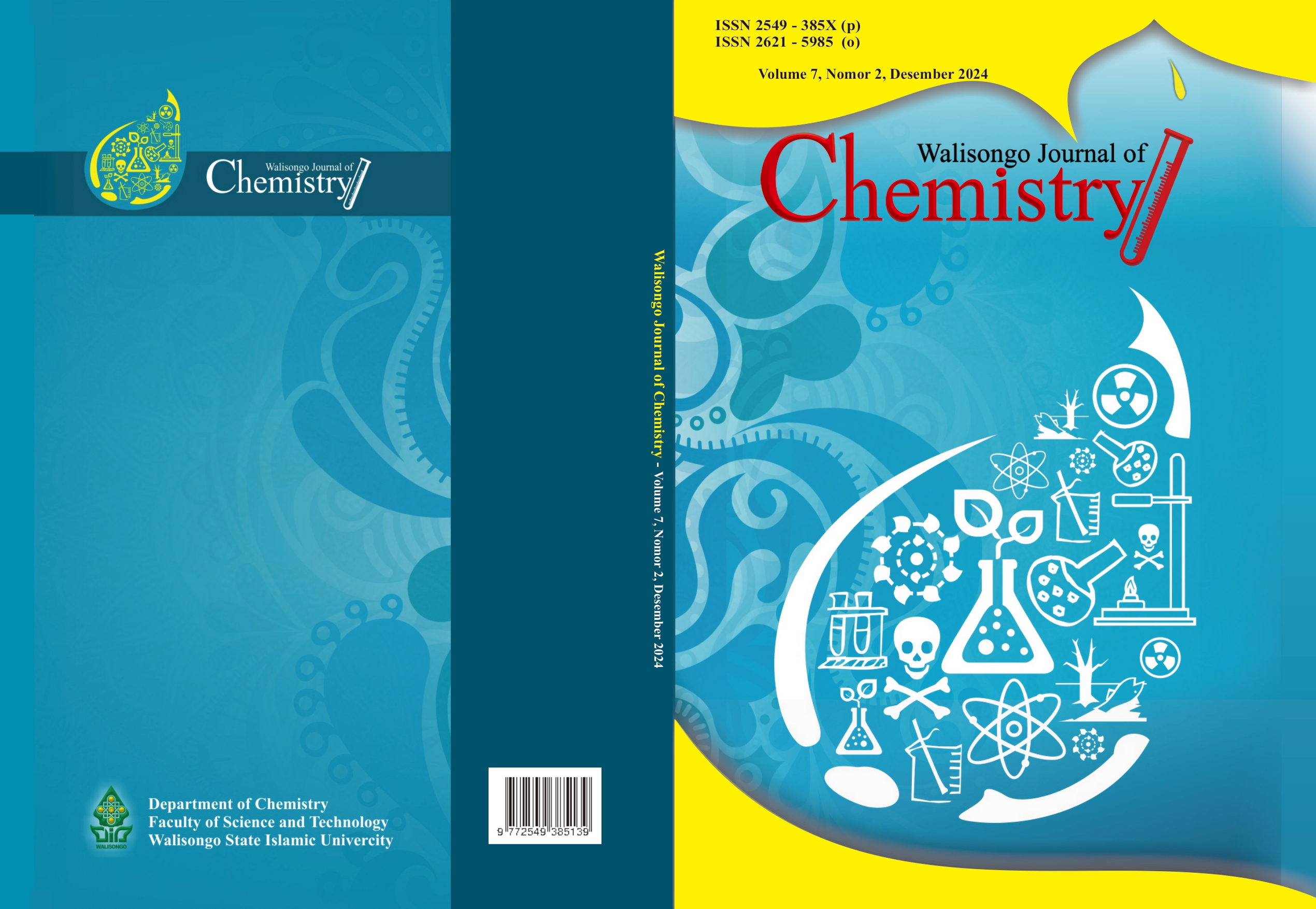Comparison of The Use of Glycerol and Sorbitol as Plasticizers on The Quality of Bioplastics Based on Cellulose-Chitosan
DOI:
https://doi.org/10.21580/wjc.v7i2.24175Abstract
The accumulation of plastic waste poses significant environmental and health problems. One effort to mitigate this issue is the development of bioplastics. Correspondingly, the primary materials used in this research were cellulose from teak (Tectona grandis) wood powder, chitosan, glycerol, and sorbitol. This study aimed to compare the effectiveness of glycerol and sorbitol as plasticizers. Glycerol is considered cost-effective, renewable, biodegradable, and environmentally friendly, while sorbitol, which is also non-toxic and naturally abundant, can enhance product durability by inhibiting water evaporation. Both materials exhibit good potential as plasticizers; therefore, their comparison is necessary. The research stages included extracting cellulose from teak wood powder, synthesizing cellulose-chitosan-glycerol and cellulose-chitosan-sorbitol bioplastics, and characterizing the resulting materials. The results exhibited the presence of functional groups such as –OH, C-H, and C-O, which were typical of cellulose, as well as N-H groups, characteristic of chitosan. The best quality for glycerol-based bioplastics was achieved with the addition of 0.5 mL of glycerol, yielding a tensile strength of 5.79 MPa, elongation of 10.3%, water absorption of 43.43%, and a degradation time of 17 days. For sorbitol-based bioplastics, the best quality was obtained with the addition of 1 mL of sorbitol, resulting in a tensile strength of 6.23 MPa, elongation of 13.7%, water absorption of 67.46%, and a degradation time of 14 days. Based on these results, sorbitol is more recommended than glycerol as a plasticizer in this study.
Downloads
References
Alfitri, Helmi, Raharjo, S., & Afrizal. (2020). Sampah Plastik sebagai Konsekuensi Modernitas dan Upaya Penanggulangannya. Jurnal Sosiologi Andalas, 6(2), 122–130. https://doi.org/10.25077/jsa.6.2.122-130.2020
Amalia, A. R., Kumara, R. F., & Putri, N. P. (2019). Manufacturing of Bioplastics From Cellulose Empty Fruit Bunches Waste With Addition of Glycerol As Plasticizer. Konversi, 8(2), 63–68. https://doi.org/10.20527/k.v8i2.6839
Asngad, A., Marudin, E. J., & Cahyo, D. S. (2020). Kualitas Bioplastik dari Umbi Singkong Karet dengan Penambahan Kombinasi Plasticizer Gliserol dengan Sorbitol dan Kitosan. Journal Bioeksperimen, 6(1), 36–44. https://doi.org/10.23917/bioeksperimen.v6i1.2795
Gian A., A., Farid, M., & Ardhyananta, H. (2017). Isolasi Selulosa dari Serat Tandan Kosong Kelapa Sawit untuk Nano Filler Komposit Absorpsi Suara: Analisis FTIR. Jurnal Teknik ITS, 6(2), 228–231. https://doi.org/10.12962/j23373539.v6i2.24098
Isnaini, S. U. N. (2019). Pengaruh Penambahan Sorbitol Terhadap Karakteristik Plastik Biodegradable Berbahan Selulosa dari Cangkang Buah Nipah (Nypa fruticans). In Skripsi.
Lailyningtyas, D. I., lutfi, M., & Ahmad, A. M. (2020). Uji Mekanik Bioplastik Berbahan Pati Umbi Ganyong (Canna edulis) dengan Variasi Selulosa Asetat dan Sorbitol. Jurnal Keteknikan Pertanian Tropis Dan Biosistem, 8(1), 91–100. https://doi.org/10.21776/ub.jkptb.2020.008.01.09
Maesaroh, Kartikawati, E., & Elvianasti, M. (2021). Upaya Peningkatan Sikap Peduli Lingkungan Melalui Pelatihan Bioplastik. Jurnal Pengabdian Kepada Masyarakat, 5(3), 360–366. https://doi.org/http://dx.doi.org/10.30651/aks.v5i3.3730
Maskun, Assidiq, H., Bachril, S. N., & Al Mukarramah, N. H. (2022). Tinjauan Normatif Penerapan Prinsip Tanggung Jawab Produsen Dalam Pengaturan Tata Kelola Sampah Plastik Di Indonesia. Bina Hukum Lingkungan, 6(2), 184–200. https://doi.org/10.24970/bhl.v6i2.239
Muhammad, M., Ridara, R., & Masrullita, M. (2021). Sintesis Bioplastik Dari Pati Biji Alpukat Dengan Bahan Pengisi Kitosan. Jurnal Teknologi Kimia Unimal, 9(2), 1. https://doi.org/10.29103/jtku.v9i2.3340
Mursalim, Munir, Fitriani, & Novieta, I. D. (2019). Kandungan Selulosa, Hemiselulosa dan Lignin Serbuk Gergaji Kayu Jati (Tectona grandits L.F) dan Daun Murbei (Morus alba) Yang Dikombinasikan Sebagai Pakan Ternak. Seminar Nasional Sinergitas Multidisiplin Ilmu Pengetahuan Dan Teknologi, 2, 323–327.
Nanda, K. P., & Azizati, Z. (2018). Pembuatan Bioplastik dari Kitosan dan Sorbitol dengan Penambahan Minyak Atsiri Serai. Walisongo Journal of Chemistry, 1(2), 78. https://doi.org/10.21580/wjc.v2i2.3106
Prameswari, M. D., Nufutomo, T. K., & Munandar, A. (2020). Penurunan Kadar BOD Dan Warna Pada Air Lindi Menggunakan Media Serbuk Kayu Jati (Studi Kasus: Air Lindi Tpa Bakung, Bandar Lampung). In Teknik Lingkungan. Institut Teknologi Sumatera.
Rojtica, M. A. (2021). Sintesis dan Karakterisasi Bioplastik Berbasis Selulosa Asetat Limbah Tebu-Kitosan-Gliserol. In Skripsi.
Sartika, M. (2017). Pengaruh Penambahan Selulosa Mikroskristal dari Serat Ijuk dan Plasticizer Gliserol Terhadap Karakteristik Bioplastik dari Pati Biji Alpukat (Persea Americana mill). In Skripsi.
Tamiogy, W. R., Kardisa, A., & Aprilia, S. (2019). Pemanfaatan Selulosa dari Limbah Kulit Buah Pinang sebagai Filler pada Pembuatan Bioplastik. Jurnal Rekayasa Kimia Dan Lingkungan, 14(1), 63–71.
Trisanti, P. N., Setiawan H.P, S., Nura’ini, E., & Sumarno. (2018). Gergaji Kayu Sengon Melalui Proses Delignifikasi Alkali Ultrasonik. Sains Materi Indonesia, 19(3), 113–119.
Downloads
Published
How to Cite
Issue
Section
License
Copyright (c) 2024 Walisongo Journal of Chemistry

This work is licensed under a Creative Commons Attribution-NonCommercial-ShareAlike 4.0 International License.
The copyright of the received article shall be assigned to the publisher of the journal. The intended copyright includes the right to publish the article in various forms (including reprints). The journal maintains the publishing rights to published articles.
In line with the license, authors and any users (readers and other researchers) are allowed to share and adapt the material. In addition, the material must be given appropriate credit, provided with a link to the license, and indicated if changes were made. If authors remix, transform or build upon the material, authors must distribute their contributions under the same license as the original.









